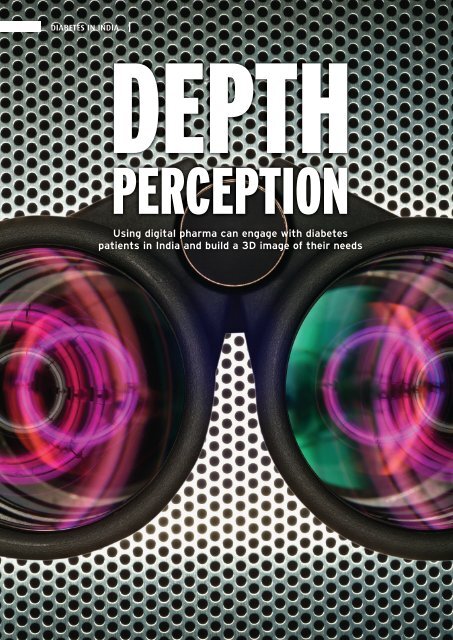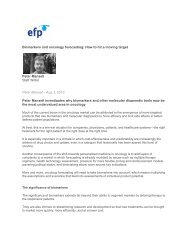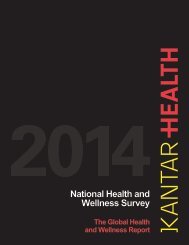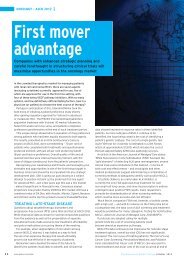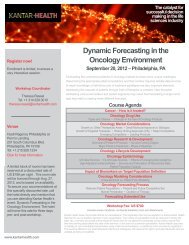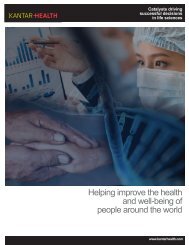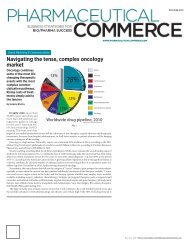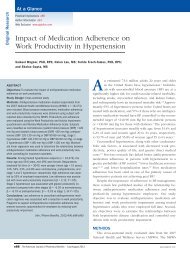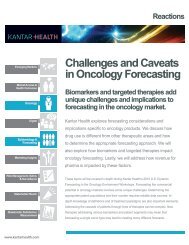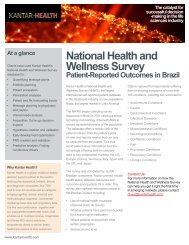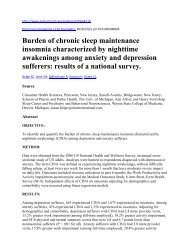Diabetes in India - Kantar Health
Diabetes in India - Kantar Health
Diabetes in India - Kantar Health
- No tags were found...
Create successful ePaper yourself
Turn your PDF publications into a flip-book with our unique Google optimized e-Paper software.
DIABETES IN INDIAThe world is be<strong>in</strong>g gripped by a diabetesepidemic with one <strong>in</strong> 10 adults worldwidesuffer<strong>in</strong>g from the disease, which is amajor cause of premature death. Globally, <strong>India</strong>is estimated to have the highest <strong>in</strong>cidence ofdiabetes with 50.8 million people liv<strong>in</strong>g with thecondition: Ch<strong>in</strong>a is catch<strong>in</strong>g up with 43.2 million.Both countries have outpaced the US <strong>in</strong> <strong>in</strong>cidenceof diabetes to become jo<strong>in</strong>t ‘diabetes capitals’ ofthe world. This trend is expected to cont<strong>in</strong>ue, with<strong>India</strong> and Ch<strong>in</strong>a mak<strong>in</strong>g up nearly 50 per centof the worldwide diabetes population by 2030.In high-<strong>in</strong>come countries like the US, 85-95per cent of all diabetes patients have Type 2diabetes. The percentage is even higher <strong>in</strong>countries like Ch<strong>in</strong>a and <strong>India</strong>, with recordprevalence of Type 2 predicted for 2030; 101million <strong>in</strong> <strong>India</strong>, 130 million <strong>in</strong> Ch<strong>in</strong>a versus 30million <strong>in</strong> the US, accord<strong>in</strong>g to the International<strong>Diabetes</strong> Federation’s <strong>Diabetes</strong> Atlas 5th Edition.Like Ch<strong>in</strong>a, where a mere 3.05 per centof patients report hav<strong>in</strong>g Type 2 diabetesand only a third (even <strong>in</strong> urban areas of thecountry) are diagnosed (far fewer than theaverage of just less than 50 per cent <strong>in</strong> therest of the emerg<strong>in</strong>g markets), prevalencefigures <strong>in</strong> <strong>India</strong> are slightly skewed becausethe disease often goes undiscovered.One-third of <strong>India</strong>n patients were diagnosed ‘byaccident’, accord<strong>in</strong>g to D-Picture, 2012 – a 360degree research programme to understand Type 2diabetes patients <strong>in</strong> <strong>India</strong>, look<strong>in</strong>g at demographicPlagued by accidental diagnosis and lack of patient compliancethe diabetes epidemic rages on <strong>in</strong> <strong>India</strong><strong>India</strong> vies with Ch<strong>in</strong>a and US for diabetes capital of the world(2030 population)Ch<strong>in</strong>a<strong>India</strong>USIn <strong>India</strong>, lack of awareness of Type 2diabetes is commonplace...…and patient education hasstill a long way to go to stemthe epidemic...130m101m30m93% 59% 67% 60%are not awareof their BMIof patientsranked “highstress” as aprimary causeOnly 1 <strong>in</strong> 3 knew the typeof diabetes they have3 <strong>in</strong> 4 patients havenever had an HbA1ctesttreated patientsregularly miss adosedo not takemedicationbecause oftheir attitude…and traditional communicationsmethods would do little to changetheir attitude and behaviourInfluencers 25%Aspirers 51%Functionals 1%Networkers 2%Communicators 6%Knowledge seekers 15%However, when segment<strong>in</strong>gpatients on the basis oftheir digital engagementlevels, over 75% showedhigh engagement levels.Is digital communication the key to Type 2 diabetes compliance <strong>in</strong> <strong>India</strong>?thout changes accompanied Pharmaceutical by this copyright notice. Market Europe November 2012 www.pmlive.com/pme 31
DIABETES IN INDIAtrends, symptoms, diagnosis, treatment anddisease monitor<strong>in</strong>g processes and <strong>in</strong>volv<strong>in</strong>g 1434patients across 15 <strong>India</strong>n cities (<strong>in</strong>clud<strong>in</strong>g Mumbaiand Delhi) and tier one towns (eg, Jaipur,Hyderabad, Lucknow, Coch<strong>in</strong>.“ … <strong>in</strong> Ch<strong>in</strong>a and <strong>India</strong>record prevalence of Type 2is predicted for 2030 … ”Family history also has a part to play … or doesit? Unlike diabetes hot spots like Ch<strong>in</strong>a and theUS – where risk factors are often hereditary –almost two-thirds of the <strong>India</strong>n patients <strong>Kantar</strong><strong>Health</strong> spoke to who had developed diabetesdid not have a family history of the disease.Although this discrepancy could be attributed tothe lack of formal records, this is unlikely to bethe case – were it so you would also expect to seesimilar trends <strong>in</strong> patients <strong>in</strong> rural areas <strong>in</strong> Ch<strong>in</strong>a.Cost and treatment coverageCost of care is a potential issue <strong>in</strong> <strong>India</strong> and isimpact<strong>in</strong>g both diagnosis and treatment. Around50 per cent of our sample were either employed orself–employed, and just 7 per cent had employerrelated<strong>in</strong>surance to cover their treatment.Medical <strong>in</strong>surance penetration <strong>in</strong> <strong>India</strong> is generallylow, even among more affluent patients, anddiseases such as diabetes are often not coveredby <strong>in</strong>surance policies. The region also suffers froma lack of <strong>in</strong>vestment <strong>in</strong> treatments: less than 1 percent of worldwide diabetes spend<strong>in</strong>g is spent <strong>in</strong><strong>India</strong> compared with the US, which accounts forover half of worldwide diabetes expenditure.“Medical <strong>in</strong>surancepenetration <strong>in</strong> <strong>India</strong>is generally low, evenamong affluent patients”As well as putt<strong>in</strong>g pressure on healthcareexpenditure, the economic burden – lostproductivity and economic growth – of diabeteslooms large, with the greatest burden be<strong>in</strong>g thecosts associated with disability and loss of life asa result of the disease and its complications.The World <strong>Health</strong> Organisation (WHO) predictednet losses <strong>in</strong> national <strong>in</strong>come from diabetesand cardiovascular disease of Int$557.7bn <strong>in</strong>Ch<strong>in</strong>a and Int$336.6bn <strong>in</strong> <strong>India</strong> between 2005and 2015. In <strong>India</strong> around 70 per cent of Type2 diabetes patients were diagnosed when theywere under 50 years-old, suggest<strong>in</strong>g that theirwork<strong>in</strong>g life was likely to be cut short.Poor disease awarenessAlongside affordability and the lack of treatmentfund<strong>in</strong>g, poor awareness of the disease isimpact<strong>in</strong>g the treatment pathway. Type 2diabetes can rema<strong>in</strong> undetected for many years,and diagnosis often results from associatedcomplications or accidently as the result ofan abnormal blood or ur<strong>in</strong>e glucose test.A recent social media study conducted amongdiabetes patients <strong>in</strong> Ch<strong>in</strong>a found they take theirdisease seriously, with over three-quarters go<strong>in</strong>gonl<strong>in</strong>e to discuss the pros and cons of therapies,diet and lifestyle. However, it seems that <strong>India</strong>npatients do not have the same approach. Onlyone-third of our <strong>India</strong>n sample could correctlyidentify the type of diabetes they have, and 93per cent were not aware of their BMI. Although50 per cent of the <strong>India</strong>n sample was overweight(compared with a whopp<strong>in</strong>g 90 per cent <strong>in</strong> the USand 41 per cent <strong>in</strong> Ch<strong>in</strong>a) and recognised weightas a contribut<strong>in</strong>g factor <strong>in</strong> their disease state,they blame stress as be<strong>in</strong>g the ma<strong>in</strong> cause.“Alongside affordability… poor awareness ofthe disease is impact<strong>in</strong>gthe treatment pathway”Patients <strong>in</strong> Ch<strong>in</strong>a and the US are activelyseek<strong>in</strong>g out solutions and educational helpfor their diabetes. However, a traditionalsegmentation of patients <strong>in</strong> <strong>India</strong> revealed that37 per cent fell <strong>in</strong>to the ‘careless and casual’category and another 18 per cent <strong>in</strong>to the ‘defiantnon-followers’ segment, mean<strong>in</strong>g that over 50 percent of our sample were <strong>in</strong> denial and/or lackedthe discipl<strong>in</strong>e required to comply with prescribedtreatment regimen. Three out of four had neverhad an HbA1c test and while most compliedwith doctor and specialist recommendationsregard<strong>in</strong>g frequency of diagnostic tests, doctorvisits and brands purchased, around 64 per centskipped doses. Most patients were not tak<strong>in</strong>g anycorrective actions <strong>in</strong> terms of diet and lifestyle.Engag<strong>in</strong>g the non-engagedThese non-compliant patient groups shouldbe targeted with market<strong>in</strong>g campaigns andmessages that are different from thoseaimed at compliant patient segments. Buthow can pharma <strong>in</strong>fluence patients <strong>in</strong> <strong>India</strong>who don’t want to comply or are <strong>in</strong> denial?In common with their counterparts fromCh<strong>in</strong>a and the US, diabetes patients <strong>in</strong> <strong>India</strong>are <strong>in</strong>creas<strong>in</strong>gly connect<strong>in</strong>g with otherpatients us<strong>in</strong>g social media and other onl<strong>in</strong>ecommunication tools. A random sample of1,030 Type 2 sufferers <strong>in</strong> urban <strong>India</strong> showedthat 12 per cent go onl<strong>in</strong>e at least once a week32 www.pmlive.com/pme Pharmaceutical Market Europe November 2012
DIABETES IN INDIA– a figure that is grow<strong>in</strong>g rapidly. Specialistcommunity sites like D-book enable patientsnot only to share their experiences with fellowpatients but to benefit from doctors’ expertiseus<strong>in</strong>g video conferenc<strong>in</strong>g and onl<strong>in</strong>e discussion.“ … diabetes patients <strong>in</strong> <strong>India</strong>are <strong>in</strong>creas<strong>in</strong>gly connect<strong>in</strong>gwith other patientsus<strong>in</strong>g social media …”Because wealthier <strong>India</strong>n patients tend to haveaccess to the <strong>in</strong>ternet, patient types <strong>in</strong> <strong>India</strong>were re-segmented us<strong>in</strong>g the Digital Life (www.tnsdigitallife.com/) onl<strong>in</strong>e classifications todeterm<strong>in</strong>e the extent of stakeholders’ activityand engagement onl<strong>in</strong>e, and to see whetherus<strong>in</strong>g ma<strong>in</strong>ly onl<strong>in</strong>e communications wouldimprove patients’ engagement and compliance.Almost three-quarters of the sample havestrong engagement <strong>in</strong> digital campaigns.Interest<strong>in</strong>gly, over half of the <strong>India</strong>n patientgroup, <strong>in</strong>clud<strong>in</strong>g non-compliant patients, fell<strong>in</strong>to the ‘aspirer’ category with high onl<strong>in</strong>e<strong>in</strong>volvement. Therefore, they would be open tothe use of social media and onl<strong>in</strong>e chat for diseaseeducation and market<strong>in</strong>g even although theydid not use these channels as much as some ofthe other groups. Another quarter of patientswere power <strong>in</strong>ternet users or ‘<strong>in</strong>fluencers’.Pharma companies look<strong>in</strong>g to educate Type 2diabetes patients <strong>in</strong> <strong>India</strong> or encourage them tocomply with a treatment regimen should explorehow to get messages across digitally. It will alsobe particularly important to utilise available datato monitor changes <strong>in</strong> epidemiology, patienteducation and both health-related quality of lifeand economic outcomes across all the diabeteshotspots. While stopp<strong>in</strong>g the spread of the diseaseisn’t possible, we can at least choose the bestmeans to educate patients, help them come toterms with their disease, and help them managetheir symptoms to achieve a better quality of life.The AuthorReena Thapar is a research managerat <strong>Kantar</strong> <strong>Health</strong>. She can be contactedat reena.thapar@kantarhealth.com.<strong>Diabetes</strong> prevalence (%)Adults aged 20-79 (<strong>in</strong> 1,000s)Adults with diabetes aged20-79 (<strong>in</strong> 1,000s)Africa 3.80 386,298 14,722Europe 8.08 653,233 52,771Middle East/North Africa 9.15 356,438 32,603North America 11.72 321,968 37,737South America 8.68 289,539 25,134Southeast Asia 8.34 856,282 71,407Western Pacific 8.54 1,544,462 131,896Source: International <strong>Diabetes</strong> Federation 2012Rank* In millionsCountryT2DPopulation*Source: International <strong>Diabetes</strong> Federation 20122011 2030 2030 m<strong>in</strong>us 2011Prevalence(%)T2DPopulation*Prevalence(%)A T2DPopulation*A <strong>in</strong> T2DPrevalence1 <strong>India</strong> 61.3 8.3 101.2 9.9 39.9 1.6%2 Ch<strong>in</strong>a 90.0 9.3 129.7 12.1 39.7 2.8%3 Bangladesh 8.4 9.6 16.8 13.3 8.4 3.7%4 Brazil 12.4 9.7 19.6 12.3 7.2 2.6%5 Mexico 10.3 14.8 16.4 17.6 6.1 2.8%6 USA 23.7 10.9 29.6 11.8 5.9 0.9%7 Pakistan 6.3 6.7 11.4 7.8 5.1 1.0%8 Egypt 7.3 15.2 12.4 17.8 5.1 2.7%9 Indonesia 7.3 4.7 11.8 5.9 4.5 1.2%10 Iran 4.7 9.3 8.4 13.1 3.7 3.8%Pharmaceutical Market Europe November 2012 www.pmlive.com/pme 33


